Elden Ring Won’t Launch? Try these fixes
Despite receiving positively reviewed by game critics and game publications, Elden Ring has a rocky launch with a lot of technical issues that ended up taking away from the wonderful experience developed by FromSoftware. One of the most common issues on PC is the inability to open the game despite the game installing just fine.

Note: If you’re having trouble installing the game, try these troubleshooting steps to complete the installation of Elden Ring.
After investigating this issue, it turns out that this problem might occur due to several different causes (on both PC and consoles). Here’s a list of potential culprits that might ultimately be causing this problem:
- Outdated Steam Client version – As it turns out if you get this problem while launching the game through Steam and the launcher prompts you to restart, the issue actually lies with your client version. In this case, you should be able to fix it by installing the latest Steam version available.
- Antivirus / Firewall interference – As it turns out, there is a possibility that your Antivirus component ends up interfering with the Elden Ring attempt to connect to the online servers. In order to prevent this issue from occurring, you’ll need to whitelist the launcher antivirus + the main game executable from your Firewall or antivirus.
- Missing admin privileges – As it turns out, you might be unable to launch Elden Ring through Steam due to the fact that the game launcher is missing admin rights. You can rectify this by modifying the default behavior of Steam to always open with admin rights.
- Corrupted game files – If the initial installation of Elden Ring was interrupted or you had a network issue while the day 1 patch hit, there’s also the possibility that your game folder contains corrupted files. In this case, running an integrity check on your Elder Ring installation should fix the problem in your case.
- Outdated GPU drivers – In case you get a GPU-related issue while trying to launch the game (from Steam or from the Standalone executable), you should also take the time to make sure that your GPU drivers & physics drivers are up to date.
- Missing DirectX dependencies – Elen Ring uses some dependencies from DirectX 12 that are not shipped with Windows 11 or 10 by default. Because of this, you should also take the time to run the DirectX Web Installer in order to make sure that you have every required dependency.
- Insufficient System resources – If you’re attempting to run Elden Ring on a low-end PC, another reason why the game might refuse to boot is the fact that there aren’t enough available system resources. In this case, you should clean boot your Windows installation in order to ensure that all your GPU, CPU, and RAM resources not used by your OS are available.
- Conflicting Overlay App – Overlay applications end up conflicting with a lot of games, and Elden Ring is no different. According to other affected users, you might be able to fix the problem by disabling the overlay software that you’re currently using to display your in-game FPS.
- Conflict caused by MSI AfterBurner or RTSS – If you’re using MSI Afterburner or RTSS, you should disable them both before attempting to launch the game once again. Apparently, there’s a driver conflict facilitated by these software products for PC running on MSI motherboards.
- Conflict with Epic Games Launcher – If you’re playing games from the Epic Store too, make sure you keep the Epic Games Launcher closes while you’re opening Elden Ring from Steam. This method seems to have worked for a lot of users that own digital products on multiple platforms.
Now that we went over every potential issue that might be responsible for this issue, let’s move on to the actual fixes. Below you’ll find a collection of methods that other users have successfully used to force Elden Ring into launching.
1. Update Steam Client
According to a lot of Elder Ring players, the reason why you might be unable to launch the game is that you’re using an outdated Steam client version. This typically happens if you previously disabled the auto-update function of Steam.
Keep in mind that Steam is now fully capable to update itself without any user intervention, but in reality, this doesn’t always happen. This seems to be a glitch that typically occurs with Windows 10.
Fortunately, you can get Steam to update automatically by simply restarting the app. You can also force the store to update by going to the ribbon bar at the top and clicking on Steam > Check for Steam Client Updates.
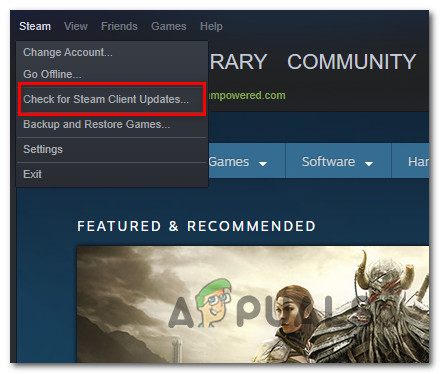
If updating using the instructions above didn’t work, chances are you’re dealing with some kind of corruption associated with Steam.
Follow the steps below on uninstalling the Steam app and then downloading the latest version:
- Press Windows key + R to open up a Run dialog box. Then, type “appwiz.cpl” and hit Enter to open up the Programs and Features window.

Open up the Programs and Features menu - From the Programs and Features screen, scroll through the list of applications, right-click on Steam and choose Uninstall.
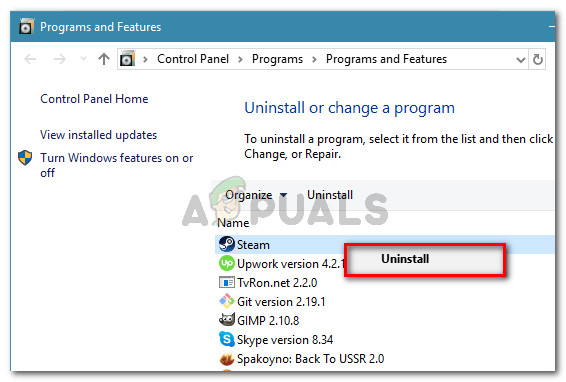
Uninstall Steam - Next, follow the on-screen prompts to complete the uninstallation of Steam.
- After the process is complete, restart your computer.
- Once the next starting sequence is complete, visit the official download page of Steam.
- Inside the Steam Download page, click on Install Steam and follow the on-screen screen to reinstall the digital store.

Download the latest Steam version - Once Steam is reinstalled, launch Elden Ring once again and see if the problem is now resolved and you are able to get past the initial screen.
In case the same problem still occurs when you try to install a game, move down to the next method below.
2. Force Steam to open with admin access
If you attempt to launch Elden Ring through Steam, you can also expect to encounter this problem due to a permission issue.
This scenario has been confirmed by a lot of Steam users and it’s typically resolved by forcing the main Steam executable to open with admin rights.
If this scenario is applicable and you want to give this fix a try, right-click on the Stream executable inside the folder where you installed it (or you can simply right-click an executable) and click on Run as Administrator from the newly appeared context menu.

Note: If you see the UAC (User Account Control) prompt, click Yes to grant admin access.
After you do this, launch Elden Ring once again through Steam and see if the problem is now fixed.
In case the game launches just fine now, but you want to avoid doing the steps above every time you open Elden Ring, follow the steps below to force to reconfigure the executable to run with admin access every time:
- Make sure that Steam is closed and no associated process is running in the background.
- Open My Computer or File Explorer and navigate to the location where you installed Steam.
- By default, you should be able to find the Steam installation in the following location:
C:\Program Files (x86)\Steam
- Next, right-click on Steam.exe and then click on Properties from the newly appeared context menu.
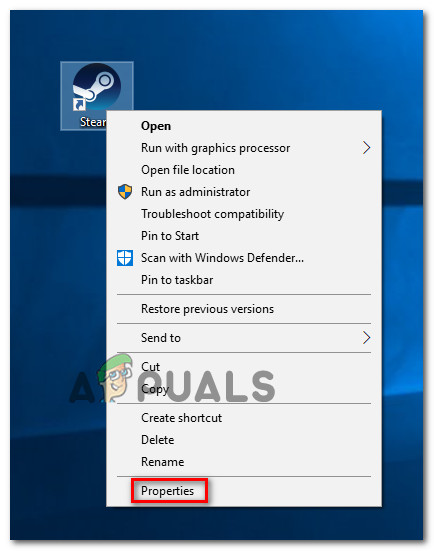
Accessing the Properties menu of Steam - Once you reach the Properties screen, access the Compatibility tab from the ribbon menu at the top, then move down to the Settings category and check the box associated with Run this program as an administrator.
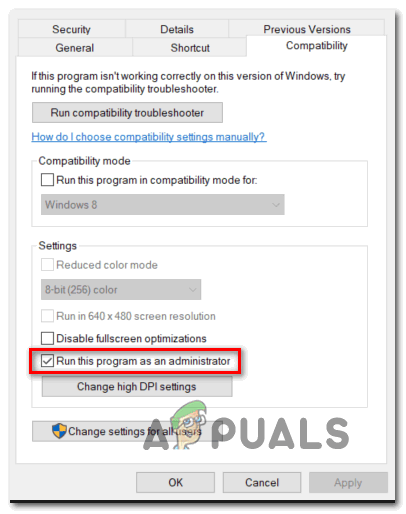
Forcing Steam to run with admin access - Next, click on Apply to save the changes permanently.
- Double-click on Steam normally to open it with admin rights.
If Elden Ring still doesn’t launch despite the fact that you reconfigured the admin permissions, move down to the next method below.
3. Whitelist Steam Launcher + Elden Ring Executable
If the methods so far didn’t allow you to launch Elden Ring normally, the next thing you should do is investigate an interference caused by a firewall component. Looking at user reports, this is pretty common among Elden Ring players.
If you’re on an older Steam build and you refuse to update, you should expect to notice that Steam connections are blocked – this can happen with both a 3rd party firewall solution or with Windows Firewall.
Important: Whatever you do, don’t run multiple firewall components at the same time. Choose one and uninstall the other.
Note: If you’re using a 3rd party suite be advised that the steps of establishing a whitelist rule for Steam will vary.
If Windows Firewall is the default suite, follow the instructions below to whitelist Steam launcher plus the used ports and ensure that Elden Ring is not prohibited from connecting to the game servers:
- Start by pressing Windows key + R to open up a Run dialog box.
- Type ‘control firewall.cpl’ and press Enter to open up the Windows Firewall window.
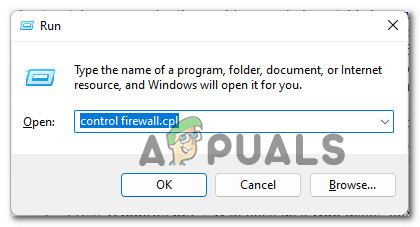
Accessing the Control Firewall menu Note: At the User Account Control, click Yes to grant admin access.
- Inside the main menu of the Windows Defender firewall, go to the left-hand side and click on Allow an app or feature through the Windows Defender firewall.
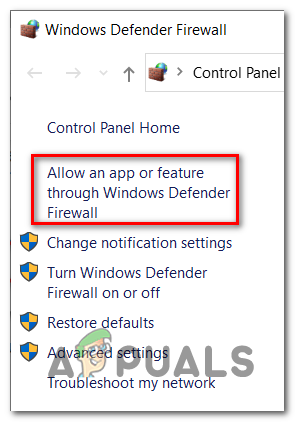
Allowing an app or feature - From the Allowed apps menu, click on Change settings button, then click on Yes when you’re prompted by the User Account Control (UAC) prompt.
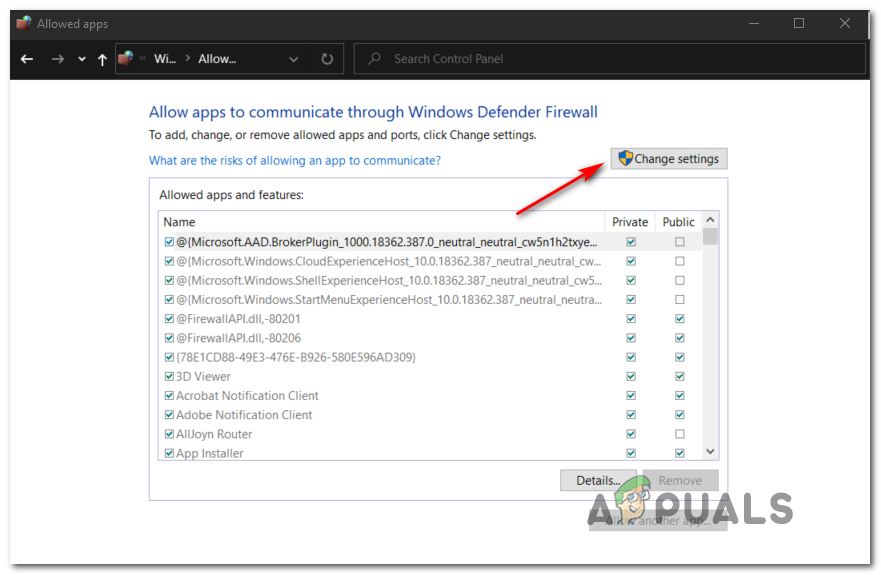
Changing the settings - Once you’re given editing control, scroll down to the bottom of the screen and click on Allow another app.
- Next, click on Browser and navigate to the location where the game is installed.

Allowing another app - Click on Browse, then add the main executable of Steam.
- Check both Private and Public checkboxes before clicking Ok to save the changes.
- Once you do step 8, return to the initial firewall menu (step 1) and click on Advanced System settings from the vertical menu on the left.

Accessing the Advanced System Settings - At the UAC prompt, click Yes to grant the requested admin access.
- Next, click on Inbound rules from the menu on the left before clicking on New Rule from the right-hand pane.

Creating a new rule - Next, you should see the New Inbound Rule Wizard appears on the screen. When you see it, click on Port when asked to select the Rule Type before clicking Next.
- From the next screen, choose TCP from the next prompt before choosing the Specific Local ports toggle.
- Next, paste the following ports in the box to prevent any TCP ports used by Steam to be blocked:
27015–27030
27036
27015
- Now we’ll need to whitelist the UDP ports. To do this, create the second rule by choosing UDP toggle.
- Next, choose Specific Local ports , and paste the following UDP ports that you wish to prevent Steam from blocking:
27015–27030
27000–27100
27031-2703
4380
27015
3478
4379
4380
- Next, click on Next and you should land directly in the Action Prompt menu.
- From the Action Prompt menu, click on Allow the connection and hit Next one final time.

Enforcing the rule - Click Finish to save the changes you just did, then reboot your computer and launch Steam after the next startup is complete and see if you are not able to open Elden Rings.
If the same kind of issue is still occurring, move down to the next method below.
4. Verify Elden Ring game files on Steam
If none of the methods above have allowed you to launch Elden Ring from Steam, you should start troubleshooting against a potential corruption issue.
As it turns out, this error could be caused by some corrupted files located inside the game installation folder.
Note: This is mostly signaled to occur in situations where the initial game installation or the day 1 patch download was interrupted by a network inconsistency.
Fortunately, Steam includes a way to check the integrity check of the game installation folder. If any files are missing or corrupted, they will be reacquired or replaced with healthy equivalents.
Here are the steps on how to verify the integrity of the Elden Ring game files:
- Start by opening the Steam app and going to the game’s library page.
- Use the left-hand section of Steam to find Elden Ring, then right-click on it and open the Properties menu.
- Next, click on Local files, on the left side section of the screen.

Browsing the Local Files - Next, click on Verify integrity of game files to start the verification, and wait until it is complete.
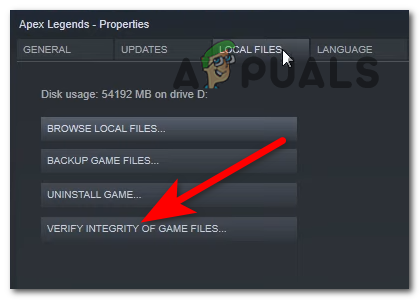
Verifying the integrity of the game files - Once the operation is complete you’ll see a message that will appear on your screen telling you if it found any corrupted files. If there were files that failed to validate, Steam will reacquire them automatically.
If this method didn’t fix the issue in your case, move down to the next potential fix below.
5. Update GPU Drivers
As it turns out, an outdated GPU driver or a missing physics module can also prevent your PC from rendering Elden Ring.
As it turns out, the game is not currently very good at giving you an error that will bring you closer to fixing the issue.
If you launch Elder Ring from Steam and nothing happens, assume it’s due an outdated or partially corrupted GPU drivers that are missing some key dependencies that are actively used by the game. You should be able to fix the issue by updating the GPU drivers + the physics module that is handling the in-game physics.
If this scenario is applicable and you haven’t updated your GPU drivers in a while, follow the instructions below for instructions to uninstall the current GPU drivers and reinstall the latest versions before attempting to launch Elder Ring once again:
- Press Windows key + R to open up a Run dialog box.
- In the run text box, type ‘devmgmt.msc’ and press Enter to open up Device Manager.

Accessing Device Manager - Once you’re inside Device Manager, scroll down through the list of installed devices, and expand the drop-down specific to Display Adapters.
- From the next menu, right-click on the GPU driver that you want to update and choose Update driver from the context menu.

Updating the driver via Device Manager Note: In case you have a PC with both a dedicated and an integrated GPU, you will need to update both drivers.
- From the next menu, click on Search Automatically for updated driver software.
- Once the initial scan is complete, follow the on-screen instructions to install the latest GPU driver that the scan has identified.
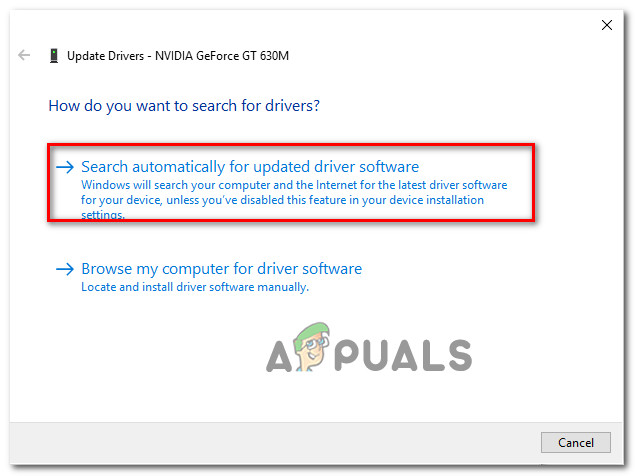
Updating the GPU drivers - Once the operation is complete, reboot your machine and launch the game at the next system startup to see if you are now able to launch Elden Ring.
Note: If Device Manager was not able to find a new GPU driver version, you should resort to using the proprietary software provided by your graphics card manufacturer to update your current graphics drivers. Here’s a list of software that you will need to use based on your GPU manufacturer:
GeForce Experience – Nvidia
Adrenalin – AMD
Intel Driver – Intel
If the same kind of issue is still occurring even or you already had your GPU drivers up to date, move down to the next method below.
6. Install the missing DirectX dependencies
Keep in mind that Elden Ring uses the very latest DirectX 12 dependencies. And it’s important to understand that some of these required dependencies (if you choose to use DirectX 12 are not included by default with Windows 10 or Windows 11.
So in order to address this potential issue, you’ll need to ensure that you have the latest public release of DirectX 12.
Several affected users that we’re also dealing with issues when launching Elden Ring have reported that the problem was finally fixed after they ran the DirectX End-User Runtime Web installer and installed every missing DirectX iteration on their computer.
Here’s how to start deploying the DirectX End-User Runtime Web installer on your PC and fix the starting issues with Elden Ring:
- Start by visiting the download page of the DirectX End-User Runtime environment.
- Once you get to the home page, select the appropriate installer language before clicking on the Download button.
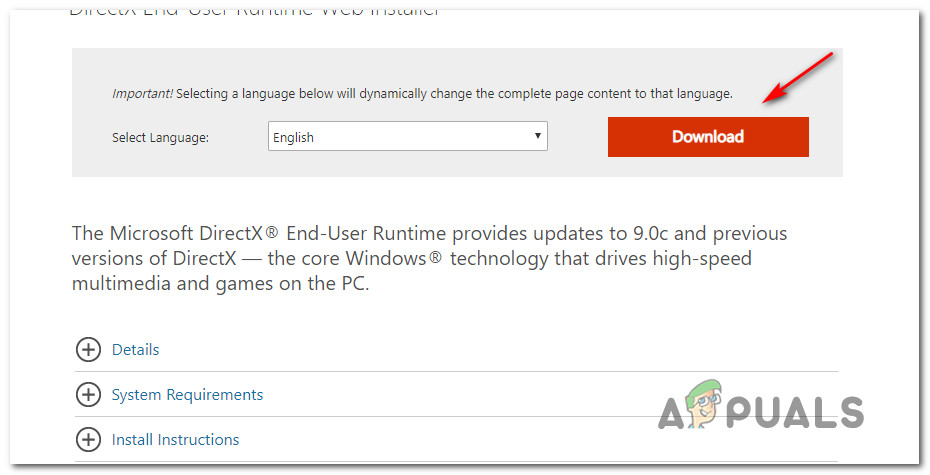
Downloading the DirectX web installer - Next, uncheck every Microsoft bloatware recommendation by clicking on No thanks and continue to DirectX End-User Runtime Web installer button.
- After the dxwebsetup.exe installer is downloaded, follow the on-screen instructions to complete the process of installing every missing DirectX version to the latest.

Accepting the Agreement - Reboot your PC and see if the problem is fixed by attempting to launch Elden Ring once again.
If the problem is still occurring, move down to the next method below.
7. Run Elden Ring in Clean Boot Mode
Keep in mind that if you’re using a low-end PC, there’s also the chance that you’ll see this problem appearing because the game doesn’t have enough free system resources to render the game.
As mentioned above, the fact that FromSoftware doesn’t have an error that properly allows players to troubleshoot the issue makes this issue much more frustrating.
Besides insufficient available system resources, another potential problem that might cause launch issues with Elden Ring is a scenario in which a system resource optimizing tool or even an optical burning software is conflicting with the Steam installation.
Since there are a lot of potential culprits (processes and startup items) that might be responsible for this problem, the best course of action would be to go for a clean boot procedure.
A clean boot operation will force your Windows to boot up without any type of 3rd party interference (only required startup services and processes will be permitted to run).

If achieving a clean boot state doesn’t fix the issue, move down to the next potential fix below.
8. Disable Overlay program (if applicable)
If you’re still unable to launch Elden Ring despite following all the other methods above and you’re always using an overlay feature to count your FPS, it’s possible that the rendering of the game is inhibited by the program enforcing the overlay.
This problem is confirmed to occur on both Windows 10 and Windows 11.
Another likely possibility is a scenario in which the problem is being caused by two conflicting overlay tools – in this case, you should be able to fix the problem by disabling the non-essential in-game overlay or by uninstalling this tool altogether.
In most cases, the problem is either produced by Discord’s in-game overlay or by the overlay feature found inside Nvidia Experience.
If you have Nvidia Experience overlay or a Discord overlay enabled, follow sub-guide 1 or sub-guide 2 to disable the in-game overlay function that’s currently active in order to stop the conflict. In case you’re using a dedicated overlay tool that you’re not actively using, you can follow the third sub guide in order to get rid of it.
Disabling Nvidia Overlay
If you’re using the overlay technology from Nvidia Experience, follow the instructions below to disable in-Game Overlay.
Here’s what you need to do:
- First things first, make sure the game is turned off, then open Nvidia Experience.
- Inside Nvidia Experience, click on the Settings icon (gear icon) from the right-hand side of the screen (at the top).

Accessing the Settings menu - Next, from the Settings menu, click on the General tab from the right-hand section.
- Once you’re inside the correct menu, move over to the left menu and disable the toggle associated with the In-Game overlay.
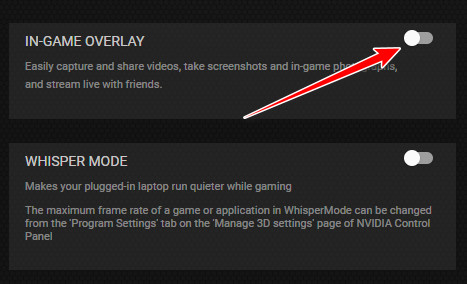
disable the in-game overlay - Launch Elden Ring once again and see if you can get past the initial screen.
Disabling Discord Overlay
If you’re using Discord’s Overlay, you will need to access the User settings and disable the overlay feature from the Overlay tab.
Here’s what you need to do:
- Ensure that the game is not running in the background, then go ahead and open the Discord app.
- If you can’t see the screen right away, go ahead and open the system tray.
- Next, double-click on the icon to bring the Discord window forward.
- Once you’re inside the Discord app, look for the User settings (gear icon) in the bottom section of the window.

Accessing the Settings menu - From the User Settings menu, click on Overlay tab from the vertical menu on the left (under App Settings).
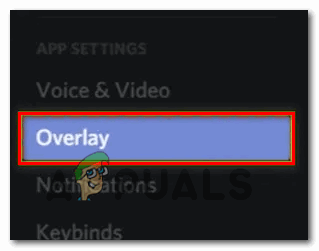
Accessing the Discord overlay features - From the Overlay menu, disable the toggle associated with Enable in-game overlay.
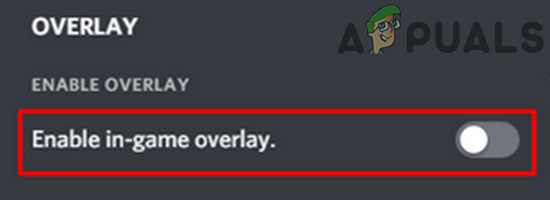
Disabling the Overlay features - Save the changes, then launch the game once again and see if the problem is now fixed.
Uninstalling the Screen Overlay feature
In the event that you have an overlay feature installed (different from Discord or Nvidia Experience) and you have no use for it, you can simply uninstall it to eliminate the possibility of a conflict.
Here’s what you need to do to uninstall the potentially conflicting overlay tool:
- Press Windows key + R to open up a Run dialog box. Next, type ‘appwiz.cpl’ and press Enter to open up the Programs and Features menu.

Open up the Program and Features menu - Inside the Programs and Features menu, scroll down through the list of installed programs and locate the overlay software that you plan on uninstalling.
- Right-click on it and choose Uninstall from the newly appeared context menu.
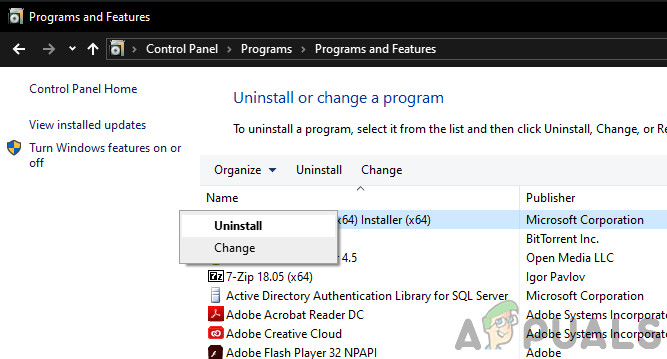
Uninstall the overlay tool - Once you get to the uninstallation screen, follow the instructions to complete the uninstallation, then reboot your PC.
- After your PC boots back up, open Elden Ring once again and see if the problem is now resolved.
In case you didn’t have an overlay feature or disabling (or uninstalling it) didn’t work in your case, move down to the next method below.
9. Uninstall MSI Afterburner and/or RTSS (if applicable)
If you are using MSI Afterburner and Rivatuner (RTSS), keep in mind that these two GPU-based features are very likely to cause the game to crash at every attempted startup.
There is no official explanation from FromSoftware yet, but the community suspects that the current game version is not fully compatible with RTSS.
Note: MSI Afterburner is a program that allows you to overclock your GPU directly from the software, and Rivatuner is a freeware overclocking and hardware monitoring program for Nvidia video cards but also has limited support for AMD video cards.
It’s important to understand that both of these apps don’t have a turn-off option – the only way to turn off the apps is to close them from the Task Manager. Press the CTRL + Shift + ESC buttons to open the Task Manager, then search the MSI Afterburner process and close it.

Important: The Rivatuner program should close at the same time as the MSI Afterburner. In case it doesn’t, end the process manually.
When you’re done with that, Elden Ring once again and see if the problem is now fixed.
If this method is still not resolved or you aren’t using overclocking solutions like Afterburner or RTTS, move down to the next potential fix below.
10. Uninstall Epic Games launcher
If you’re experiencing this issue while attempting to launch the game from Steam, ensure that you don’t have the Epic Games launcher installed.
According to a lot of issues, the launch of Elden Ring via Steam is somehow inhibited while the Epic Games Launcher is also running in the background. Most likely, this problem will be patched in the next major patch from FromSoftware, but until then, the only course of action is to disable or uninstall the Epic Launcher.
Start by ensuring that the Epic Games launcher is not running in the background before attempting to launch Elden Ring once again.
If the same kind of problem is still occurring, follow the instructions below to uninstall the Epic Games launcher:
- Press Windows key + R to open up a Run dialog box. Next, type ‘appwiz.cpl’ and press Enter to open up the Programs and Features menu.

Opening up the Programs and Features menu - Once you’re inside the Programs and Features menu, scroll down through the install apps and locate the Epic Games Launcher.
- When you see it, right-click on it and click on Uninstall from the context menu.

Uninstall the Epic Games launcher Note: You don’t need to uninstall the Epic Online Services too since that’s not a dependency known to conflict with Elden Ring.
- Inside the uninstallation screen, follow the on-screen prompts to complete the removal of the Epic Games Launcher, then reboot your PC.
- Once your computer boots back up, see if the problem is now resolved by attempting to launch Elden Ring once again.




